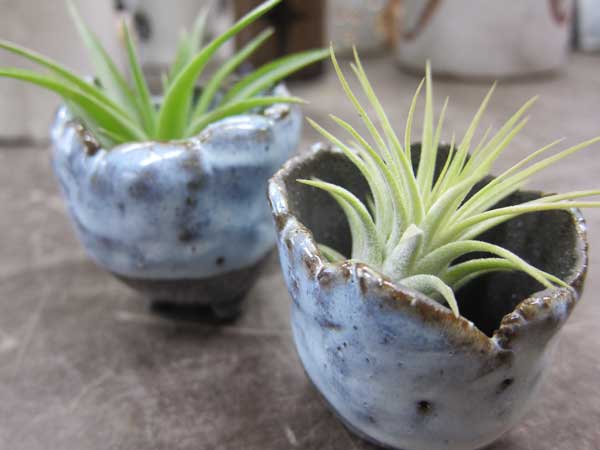
Narrow garden path on balcony has many levels and lots of ceramics



史火陶芸教室で作った花瓶に、ベランダの植物を入れました。このピンクバラはいい香りがします。形と香りのために、ローズマリーも一緒に入れてみました。
Using balcony plants, I created this small arrangement in a ceramic vase I made at Shiho. This pink rose has a good scent, and i added rosemary for additional scent and its mix of hard needles and curvy stems.

Does your local florist include mini-apples in their arrangements? It’s very common now in Tokyo, and I think it adds a fun element. This wall vase I made at Shiho ceramic studio.
 エアプラントと盆栽の陶芸の組み合わせ はどうでしょう? 史火陶芸教室の展示会のために、いろいろ盆栽用の陶芸を準備しました。不思議な組み合わせですけど、エアプラントの形と遠い起源を考えると楽しいです。さらに取り出しやすいので、鉢をよく見ることができます。
エアプラントと盆栽の陶芸の組み合わせ はどうでしょう? 史火陶芸教室の展示会のために、いろいろ盆栽用の陶芸を準備しました。不思議な組み合わせですけど、エアプラントの形と遠い起源を考えると楽しいです。さらに取り出しやすいので、鉢をよく見ることができます。
Preparing for the Shiho student show last month, I wondered how to show off the bonsai pots I made this year. I tried one with only gravel, and another with a tiny succulent. My favorite is perhaps the oddest combination: air plants. I like their shapes and their distant origins in a different climate. And I like how you can easily take them out and examine the pot. What do you think about this combination?

紫式部の果実は薄緑の葉に似合います。この特別な秋の植物は『5倍緑』という都市里山箱のなかで成長します。史火陶芸教室の前を、歩行者が注目しています。季節ごとに、小さい風景ができあがります。史火のホームペジで、この5倍緑箱が二年前にどんなだったかを見られます。
I love how the purple berries pop against the light green foliage. This hardy shrub is a classic fall marker, and a reference to the female novelist of the thousand year old Tale of Genji. Unlike my balcony specimen, which dropped its berries while still green, this one outside Shiho ceramic studio looks fantastic. It’s growing in a 5bai midori, the modular urban satoyama box.
I bought the first box two years ago, and the second last year. They really thrive on this north-facing sidewalk and draw attention to the studio and store. If you click on Shiho’s website, you can see on the home page how small the first one was. It just needs lots of water, and very occasional pruning. There are so many local species that each season has something special and evocative of the Japanese landscape.